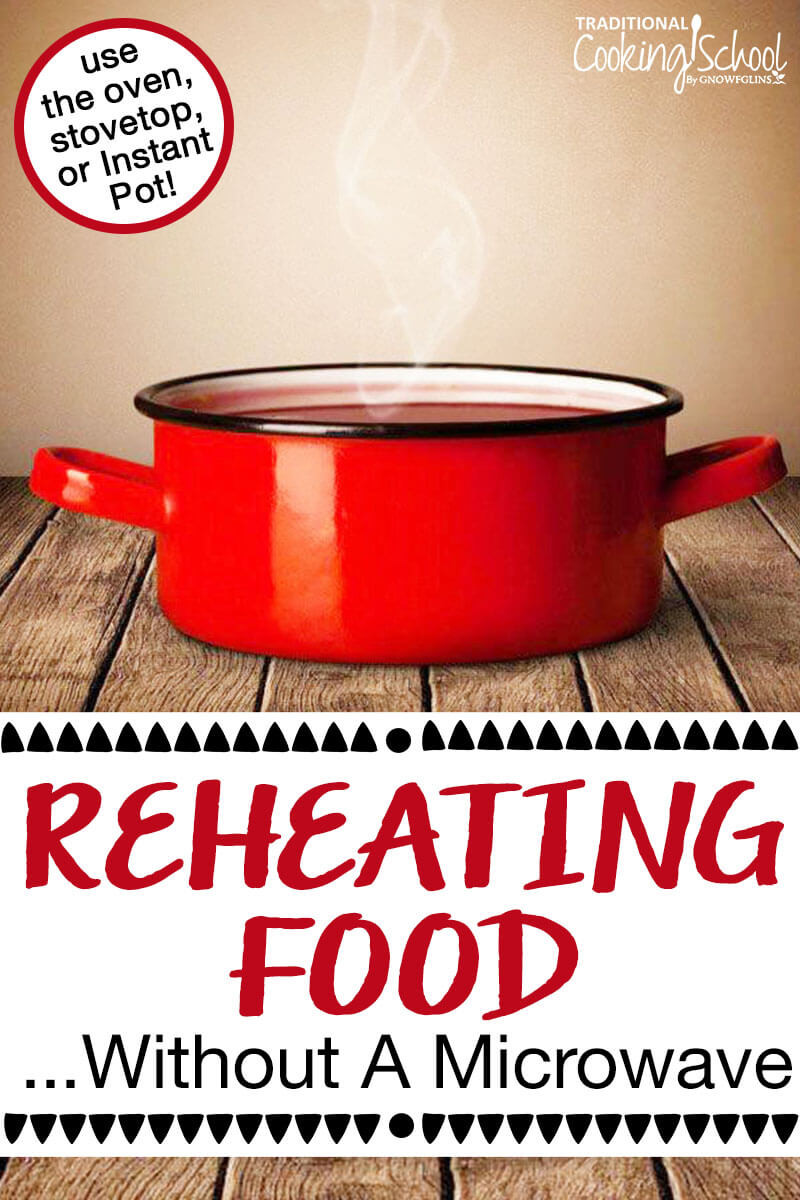 Steaming red pot on a stove, illustrating a natural and healthy method for reheating leftover food without microwave ovens, emphasizing stovetop cooking as a convenient kitchen alternative.
Steaming red pot on a stove, illustrating a natural and healthy method for reheating leftover food without microwave ovens, emphasizing stovetop cooking as a convenient kitchen alternative.
For years, many have chosen to live without a microwave, driven by beliefs about healthier eating. If you’re considering ditching your microwave or simply need alternatives, this guide offers practical ways to reheat food effectively and easily. The aim here isn’t to persuade you to remove your microwave, but to provide you with the knowledge and methods to confidently reheat food without one, should you choose this path.
Initially, transitioning away from microwave convenience might seem challenging. However, the shift is surprisingly straightforward once you decide to embrace it. Many find that the perceived convenience of a microwave is easily matched, and often surpassed, by simple stovetop or oven methods. Beyond convenience, eliminating a microwave offers additional benefits. It frees up valuable kitchen counter space, and using alternative heating methods often results in more evenly heated food, avoiding the dreaded “hot spots” microwaves can create. Furthermore, many believe that avoiding microwave radiation contributes to more healthful eating habits.
While the advantages are numerous, there’s one minor drawback: more dishes. Reheating on the stovetop or in the oven naturally involves using pots and pans. However, this can be minimized with planning, like reheating entire meals in a single pot or reusing the same cookware for different dishes. Ultimately, the slight increase in dishwashing is a small trade-off for the benefits gained.
Let’s explore specific methods for reheating various types of food, demonstrating just how simple and effective microwave-free reheating can be. In most cases, a little added water and medium heat are all you need.
Drinks
Reheating beverages is incredibly simple. Pour your drink into a suitable pot. Heat over medium to medium-high heat until it reaches your desired temperature, or a simmer. You’ll find that for many drinks, like tea or coffee, the reheating time is comparable to using a microwave. Alternatively, for a gentler approach, especially for delicate liquids, you can place the drink in a mason jar, set the jar in a pot of water, and heat the water to a simmer. This indirect heat method is particularly useful for liquids that can scald easily, such as milk; in this case, use medium or medium-low heat and stir continuously until heated through.
Foods In Sauce
Reheating saucy dishes like spaghetti sauce or pre-made meals with gravy is also a breeze. Select a stainless steel or cast-iron pot appropriate for the quantity of food. Place the food in the pot and heat over medium or medium-high heat until warmed through. If the sauce has thickened during refrigeration, simply add a bit of water to reach your desired consistency. Start with a quarter cup of water at a time, stirring it in until you achieve the right texture. Remember, sauces will naturally thin out as they heat up.
Foods Without Sauce
For foods lacking significant sauce, such as cooked meats, potatoes, or steamed vegetables, a pan and a touch of moisture are key. Place the food in a stainless steel or cast-iron pan. Add a small amount of water, oil (like olive, coconut, or red palm oil), or broth. Heat over medium to medium-high heat until warmed. The added liquid prevents drying and can even create a light sauce as it cooks. Another technique is to use a steaming method. Place the food in a smaller pan that nests inside a larger pan filled with boiling water. The steam from the boiling water will gently reheat the food. Seasoning can be adjusted as needed during reheating to refresh the flavors.
Whole Grains
For reheating grains like brown rice, quinoa, or millet, a well-seasoned cast-iron pan or pot is ideal. The seasoned surface of cast iron is naturally non-stick, which helps prevent grains from sticking excessively during reheating. However, even if some sticking occurs, it’s usually easy to scrape off as long as the grains aren’t heavily burned.
Melt a generous knob of butter, ghee, or coconut oil in the cast-iron pan over medium heat. Add the cooked grains and stir or scrape frequently as they heat up. Reheating is a perfect opportunity to enhance the flavor of your grains. Season with salt, pepper, herbs, or spices as you reheat. Once the grains are heated through and flavorful, reduce the heat to low and cover the pan to keep them warm until serving. You may sometimes want to add a splash of water or sauce if the grains seem dry.
Pasta
Reheating pasta simply requires a stainless steel pot, a little water, and a touch of oil (olive, coconut, or red palm oil work well). Place the pasta in the pot with a bit of water and oil. Heat over medium heat. As the water heats and turns to steam, it will gently reheat the pasta. Keep the pot covered to trap the steam, but toss the pasta frequently to ensure even heating and prevent sticking. Add more water as needed, but be cautious not to add too much, which can make the pasta soggy. The goal is just enough water to create steam for reheating. Season with salt or other desired seasonings as you reheat.
Beans
Reheat beans in a stainless steel or cast-iron pan with a bit of added water or oil. The process is very similar to reheating “Foods in Sauce.” Add a little liquid to prevent drying and heat over medium heat until warmed through. Season to taste as needed.
Porridges and Hot Cereals
For reheating porridges and hot cereals like oatmeal, use either a stainless steel or cast-iron pot. Place the cereal in the pot and add a generous amount of water. Stir well to break up any lumps. A bamboo stir-fry spoon or even a potato masher can be helpful for breaking up larger chunks. Turn the heat to medium or medium-low. Stir frequently with a wooden spoon to prevent sticking, and cover the pot between stirs to retain heat. Continue reheating, adding more water as needed to achieve the desired consistency. If you accidentally add too much water, simply simmer the porridge uncovered for a few minutes to allow excess water to evaporate. Once heated through, reduce the heat to low and cover the pot to keep it warm.
Melting
Melting chocolate or solid oils like coconut oil can be easily done on the stovetop using low heat and stainless steel cookware. Place the item to be melted in a stainless steel pot and heat gently, stirring constantly. Remove from the heat as soon as it’s fully melted to prevent burning. Avoid boiling unless specifically instructed in a recipe. Alternatively, for a gentler melting method, you can create a double boiler. Place the ingredients to be melted in a smaller pot or heatproof bowl and set it over a pot of simmering water, ensuring the bottom of the smaller pot doesn’t touch the water. Stir and let the steam gently melt the contents.
Using the Oven or Toaster Oven
Reheating larger portions or main dish leftovers in the oven is an excellent method for even heating and maintaining texture. Place the food in a covered casserole dish and reheat at 350 or 375 degrees Fahrenheit (175-190 degrees Celsius) for about 30 minutes, or until heated through to the center. Combining different meal components in the same casserole dish can save space and reduce cleanup.
For single servings, smaller quantities, or delicate items like fruit desserts, a toaster oven or conventional oven can be used. Reheat for shorter periods, starting with 5 minutes, and check the temperature. Continue heating in short intervals until the food reaches the desired warmth.
Using The Instant Pot
The Instant Pot offers another convenient method for reheating food without a microwave. While a detailed tutorial is available here, it essentially uses steam to gently and quickly reheat food, much like a microwave but without microwave radiation.
Final Thoughts
As you can see, reheating food without a microwave is not only feasible but also often results in better tasting and more evenly heated meals. These simple stovetop, oven, and even Instant Pot methods are easy to incorporate into your kitchen routine. Experiment with these techniques and discover your favorite microwave-free reheating solutions. If you have any questions about specific methods or food types not covered, please ask!



